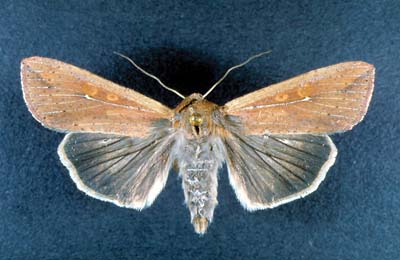True Armyworm, Pseudaletia unipuncta
(Lepidoptera: Noctuidae)
The armyworm is a native species that can be found most commonly in the eastern United States but is distributed throughout North America. It does not overwinter in northern latitudes but disperses northward each year. Natural enemies are known and identified, and help to keep populations under control. As much as 40% of armyworm infestations are reported to be parasitized by naturally occurring parasitoid wasps. High infestations generally occur during wet years. The number of generations that occur each year varies from two to six. The complete life cycle takes from 30 to 50 days. Eggs are white or yellow and turn gray just before they hatch. The larvae are grayish-green and have a dark head and longitudinal stripes down the body. The pupa is mahogany brown and can be found in the soil. The adult is a reddish-brown moth and the front wing has a line of black spots. The tip of the wing has a black line at the end of the spots. One to two white spots may also be present on the front wing. The hindwings are grayish.
Vegetables that are commonly attacked include artichoke, bean, cabbage, carrot, corn, celery, cucumber, lettuce, onion, parsley, parsnip, pea, pepper, radish, sweet potato, and watermelon. Damage is caused by the larvae that feed on plant foliage. Sampling techniques include pheromone traps and visual analysis of plant tissue. Insecticides are commonly used to manage high populations. Bacillus thuringiensis may also be used to suppress the armyworm.
Images
To save the Web-optimized images shown below to your hard drive:
PC users: right click to "Save Picture (or Image) As..."
Mac users: click and drag to your desktop.
Copyright © 2005 University of Florida
